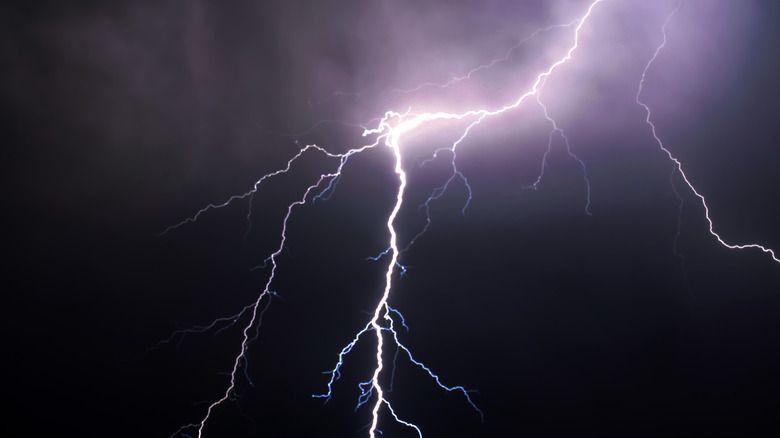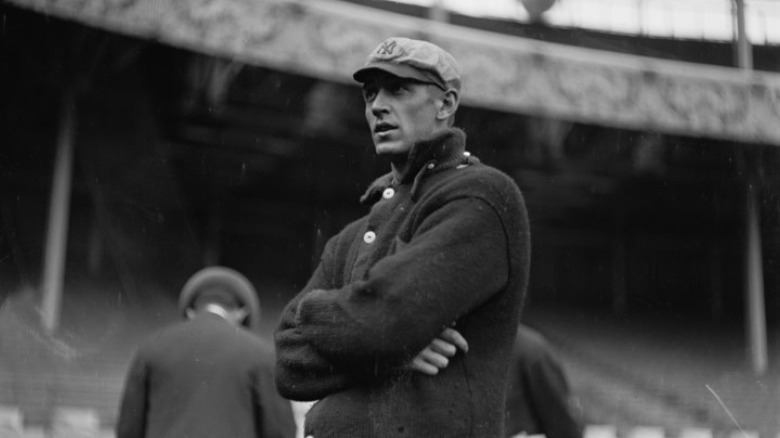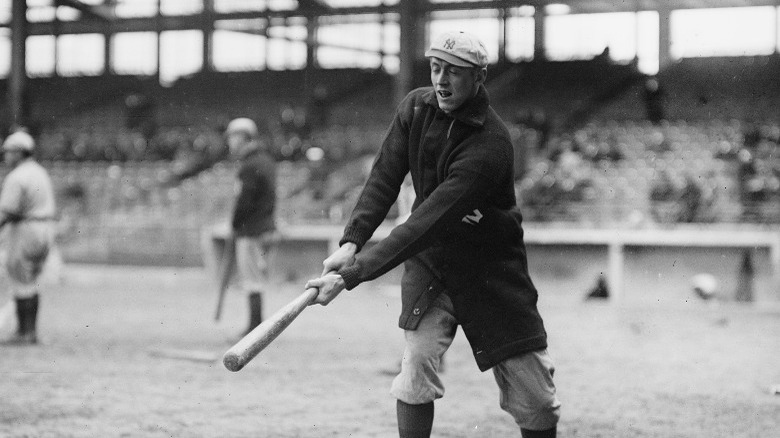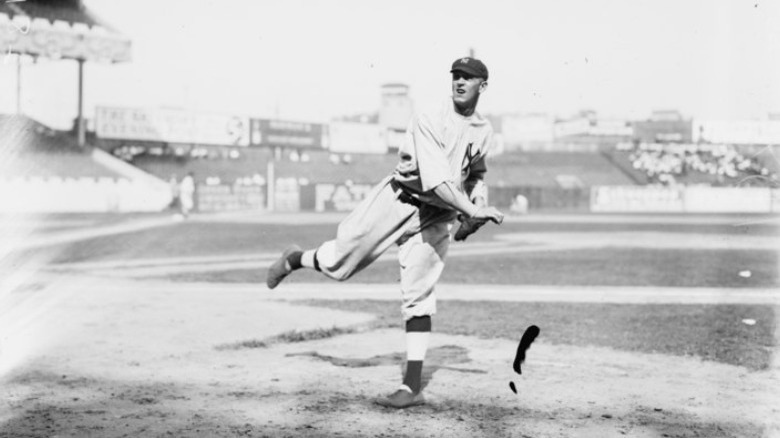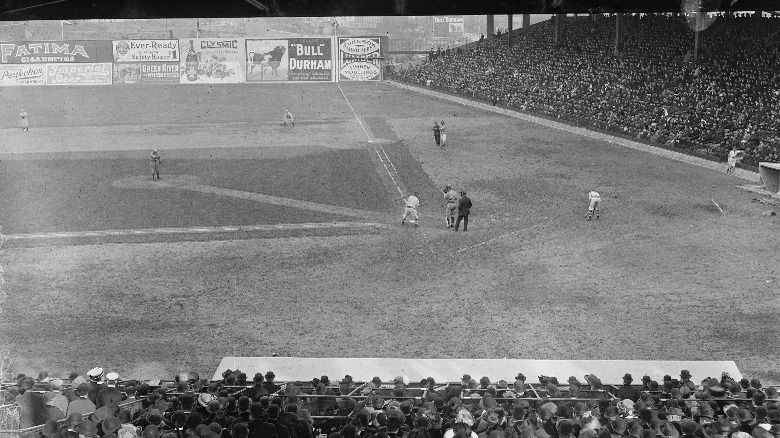Inside The Time A MLB Pitcher Was Struck By Lightning During A Game, And Still Got The Final Out
There are two words baseball fans loathe: weather delay. They're a necessary evil, but no one likes weather delays. When they happened back in the day, fans were forced to sit through sitcom reruns or old movies no one had even thought about for decades Instead of watching their favorite team play nine innings. While frustrating, a good way to get yourself through a rain delay is to remind yourself that they aren't a part of the game bent on instilling boredom, they're only there for the sake of safety. Plus, sometimes rain delays produce the always funny blooper of a grounds crew guy tripping while trying to put the giant tarp in place.
Nowadays, high-tech weather radar can alert the necessary personnel if a storm even has a sliver of a chance of drifting near a stadium. However, baseball has been around a long time, even back in the days when a guy licking his index finger and sticking it in the air to determine where the wind was coming from was considered cutting-edge meteorological technology. Back in the early 20th century, inclement weather could sneak up on a baseball game, and during a 1919 game, Cleveland Indians pitcher Ray Caldwell was actually struck by lightning. Surprisingly, he stayed in the game and led his team to a victory, per ESPN.
Ray Caldwell's pre-lightning strike baseball career
According to Baseball Reference, Ray Caldwell was born in Corydon Township, Pennsylvania way back in 1888. According to ESPN, Caldwell's parents divorced when he was young, even though it was far from common or socially acceptable. His father moved over to Europe, while his mother stayed in the U.S. and remarried. Caldwell's stepfather was a telegraph operator and it was that line of work — not baseball — that fascinated him when he was a kid. He went on to spend his off-seasons away from the baseball diamond as a railroad telegraph operator.
When Caldwell grew up he was listed at 6' 2” and 190 pounds, measurements that earned him the nickname slim. He used every inch and pound he had to fire baseballs across home plate, and at 20 years old he signed with a semi-pro club. By 1910 the then-22 year old signed a deal with the New York Yankees. Caldwell spent nine seasons with the Bronx Bombers, and according to ESPN, his calling card became his spitball, which was still legal at the time. Eventually, his frequent bouts with alcoholism became a real problem, per the MLB. He left the Yankees in 1918 without notifying the club, and in 1919 they dealt him to the Boston Red Sox.
Caldwell makes his way to Cleveland
His drinking continued in Boston, where he was roommates with none other than Babe Ruth. He lasted less than a year with the Red Sox before they cut him loose. Caldwell's baseball future looked grim, but fortunately for him, the Cleveland Indians were in a tight race with the Chicago White Sox and needed a right-handed pitcher.
The Cleveland Indians — who have since changed their name to the Cleveland Guardians — offered to use an unorthodox method to manage the notoriously difficult Caldwell and his propensity to drink. They told him that after each start he could go get drunk, and then wouldn't have to go to the clubhouse the next day. After that, though, he had to return to the team and prepare for his next start (via the MLB). Caldwell signed with Cleveland and made his debut on August 24, 1919, where he took the hill against the Philadelphia Athletics, per Baseball Reference.
Caldwell's electrifying performance
Looking at the box score from the game (via Baseball Reference), Caldwell had a solid, if not remarkable game. He pitched a complete game, allowing four hits and one run in the process, and out-dueled Philadelphia's Rollie Naylor. In the batter's box, Caldwell had a hit and a strikeout in three plate appearances and even took a free base after getting plunked by Naylor. However, the most memorable part of the game doesn't show up in the box score.
According to the Chautauqua Sports Hall of Fame, it was the top of the ninth inning, and Caldwell stood on the hill with the Indians ahead 2-1 as dark storm clouds quickly rolled off of Lake Erie and darkened the Cleveland sky. This was nothing new for Cleveland's players, and they hoped to lock up three outs in a hurry. The Indians managed to get two outs before the storm fully hit their stadium, League Park. As Caldwell prepared to notch the final out of the game, a bolt of lightning pierced through the sky, and when everyone finally got their wits together, Ray Caldwell was sprawled out on the mound.
Teammates ran over to him, and fortunately, he quickly woke up and insisted on finishing the game. All the players returned to their positions — despite what they had just witnessed — and Caldwell prepared to face Athletics shortstop Joe Dugan, per SABR. Dugan got a hold of a pitch but it didn't amount to anything, as he grounded out to end the game, resulting in a shocking Indians victory.
The aftermath
According to SABR, Caldwell said in a postgame interview that the lightning strike "felt just like somebody came up with a board and hit me on top of the head and knocked me down." Caldwell looked himself over and found that he had some burns across his chest. While it was unlikely, the theory at the time was that the metal button on the top of Caldwell's cap had attracted the lightning bolt, which then coursed through his body before exiting via his metal cleats. Modern-day experts — like Dr. Mary Ann Cooper, founding director of the African Centres for Lightning and Electromagnetics — dispute this idea and even call to question whether or not Caldwell was the victim of a direct strike at all, as opposed to a bolt of lightning that struck near him.
Caldwell not only finished the 1919 season with Cleveland, he stayed with the club for two more years. His abilities started to take a dip, however, and after his 1921 major league campaign he spent the next 12 seasons in the minors before retiring in 1933, per ESPN. After leaving professional baseball Caldwell continued working as a telegraph operator, but also spent time running a farm, working as a casino greeter, and coaching kids. He died in 1967 at 79 years old (via Baseball Reference).
